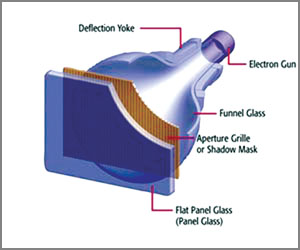|
Sonic's Desktop
Graphical Output Devices
In our last few editions, we've been
going deep into various types of computer hardware. We first categorised
the hardware components that we find in a computer system as input
devices, output devices, systems unit and secondary storage.
Then we went in to specific details of various input devices that are
available today. We started our exploration about output devices in our
previous edition, and today, let's have a look at a particular type of
output devices
|

Basic parts of a CRT monitor
|
graphical output devices.
These output devices are the most common output devices you see
today. These are none other than the 'computer display monitors' or in
simple terms, 'monitors.' The functions of these will be very familiar
to you because you are familiar with television.
This means that monitors give you the opportunity to view what is
going on in your computer in a graphical mode. This is done by letting
you see images or pictures which are generated by the computer. These
pictures may change very fast or slowly depending on the situation.
Since you are clear about the output produced through the monitor,
let us look at some technologies used in monitors which have their own
advantages and disadvantages.
Today we'll take a look at CRT monitors, which are the most common
monitors seen around.
****
Cathode Ray Tube (CRT)
You may not be familiar with what a cathode ray tube is right now,
but you must know that the big TV sets at your homes are generally in
this category. We will simply see how images appear on the screen of a
CRT monitor.
These monitors have what is called a picture tube. It is because of
this tube that the normal TVs become large towards the back of the TV.
The back of this tube is a cathode. This means it is negatively charged.
The electron guns produce electrons, and they are shot on to the
screen from behind. The screen is coated with a pattern of dots that
glow when struck by electrons. Each cluster of three dots(one of each in
the colours, red, blue and green), is known as one 'pixel'.
The screen is divided in to tens and thousands of such pixels. So,
you would understand that the smaller the pixel, the more detail there
would be in the picture, making it more realistic. This is determined by
the screen resolution, which refers to the number of distinct pixels in
each dimension that can be displayed.
The pictures of a monitor undergo change very quickly and it is known
as 'refreshing'. The videos and other moving images can be seen when the
pictures generated move rapidly. The number of times that the electron
gun redraws the entire image in one second is called the 'refresh rate'.
****
Advantages of CRT monitors
* CRT monitors run at a high resolution.
* They can produce a very dark black and the highest contrast levels
normally available. They are suitable for using even in dimly lit or
dark environments.
* CRTs produce the very best colour and gray-scale, and are the
reference standard for all professional calibrations.
* CRTs are less expensive than comparable displays using other
display technologies.
***
Problems with CRT monitors
* At relatively low refresh rates, the one who is looking in to the
screen may feel a 'flicker' in the image. This may cause eyestrain and
nausea.
* If the same image is left to be displayed for a long time, it can
permanently embed that image to the phosphor coating of the screen. This
is known as 'screen burn'. The result of this is seeing 'ghostly' images
of the picture even when the screen has changed, or is even turned off.
* Since the picture tube is quite long, this sort of monitor takes up
a considerable amount of space.
* Not suitable to use in very bright environments.
* They consume a lot of power and produce a lot of heat.
****
Sonic's Q&A
Q - What is a vacuum tube?
A - A device which could amplify,
switch or modify a signal by controlling the movement of electrons in a
vacuum (evacuated) region.
Q - When were vacuum tubes used in
computers?
A - During the first generation of
computers (1939-1954).
Q - What was the major invention
that took place in the second generation of computers?
A - The invention of the
'transistor'.
Q - Who invented the transistor?
A - It was invented by Schockley,
Bardeen and Brattain at Bell Labs.
Q - Who invented the 'Integrated
Circuit'?
A - Jack Kilby of Texas
Instruments.
Q - What is the importance of the
fourth generation?
A - The invention of the
microprocessor.
Q - What was the world's first
sealed hard disk?
A - 'Winchester' made by IBM in
1973.
Q - Who started the production of
computer game cartridges?
A - Nintendo of Japan.
Q - How can the entire computer be
categorised?
A - Hardware, Software and
Liveware.
Q - What is hardware?
A - All what you can see and feel
of a computer. In other words, the physical parts of the computer.
Q - What is software?
A - The means by which hardware
communicate with each other. Simply speaking these are programmes that
control the computer.
Q - What is Liveware?
A - The people who are associated
with operating the computer.
Aravinda Dassanayake |
